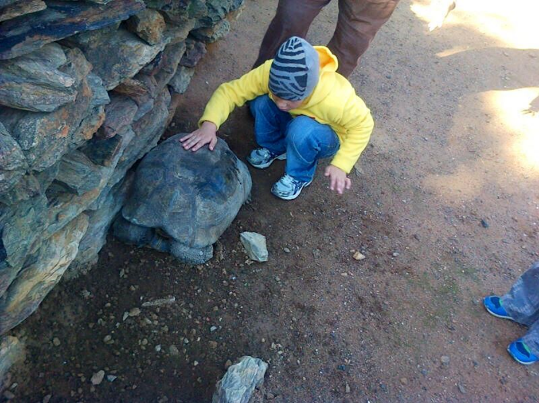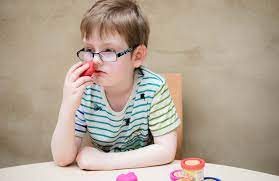It can often be hard for your child to fill in the gaps or to fully understand what’s going on around them. That is why, especially when they are little, they need your help to explain to them how the world works or how people accomplish simple tasks.
Your child will also need you to show them everything in their environment, like the gum ball machine at the grocery store or the toy ride car at the mall. You may think your child is so well behaved because they never beg to ride the car or buy a gum ball, but maybe they just don’t know they are there!
Consider this scenario:
Susan is three years old and has been totally blind since birth. Every day mom toasts a slice of bread for Susan’s breakfast. Every morning, Susan hears her mom place the slice in the toaster and later she hears the toaster’s bell “ding” when the toast is done.
Every morning, Susan says “Breakfast is ready!” when she hears the toaster’s bell. Her mom thinks she has a complete understanding about how breakfast is made, especially because she knows when her toast is ready.
But Susan has never touched the bag that her bread comes in, has never felt how cold the bread is before it is toasted, and has never touched the toaster or the toaster’s buttons. She doesn’t know that her mom buys the bread at the grocery store or that it is kept cool until she eats it. Does Susan really understand how her breakfast is made?
Obviously, Susan is missing out on many key connections in the entire process of making her breakfast. It’s important to think about how you can help your child understand what’s going on around them and include them in everyday activities.
Also think about the experiences they will need to become successful independent adults, like being familiar with public transportation or knowing how to make their own meals.
Below is a list of simple activities you can share with your child to help them understand the world around them:
In the Home
- Help load the washing machine and dryer.

- Dial numbers on the phone and call people you know.
- Help make the bed. Notice how the bed feels different when it is made and when it is still unmade.
- Place toys in the freezer or under a heating pad. Play with the cold and warm toys and talk about the difference.
- Check out the family shoes. Talk about why some are big, and some are small.
- Help set the family answering machine and record the message. Then call your house when you’re out.
AT THE PARK OR IN THE GARDEN
- Plant fruits and vegetables or visit a greenhouse, nursery or farm so your child can see where their food comes from.
- Pull up a plant and examine the roots.
- Dig in the garden or in the sand.
- It is often helpful to connect your emotions to what you are describing. For instance, the colour blue is ‘cool’ (as opposed to warm) and the colour red is ‘warm’. ‘This leaf has turned so red in this autumn season that it feels warm in your hand doesn’t it? The sun has given it warmth.
- Listen to the sounds of nature, the songs of birds, the howl of dogs, the whisper of the wind in the trees.
- Smell the myriad of wonderful scents, from lilacs to the smell of wet dogs to the noxious odours of skunks.
- Feel textures – the papery roughness of bark to the softness of mosses, to the warmth of rabbit fur.

Cognitive Development – Thinking Skills
The changes in childhood (especially the first few years of life) are remarkable. The experiences children have growing up shape their character, as well as the adults they will become. Children develop thinking skills by having numerous opportunities to play with the people and objects around them. Any activity which helps a child learn, gives them new ways to think about the world. Read more about cognitive development (thinking skills) in the previous section.
As many parents experience, pets can play a significant role in positive childhood development. Pets, or even just contact with animals, are very beneficial for children with sensory, physical and neuro diverse disabilities. Instead of just trying to explain to a child with a visual impairment or other disability what animals look like through toys or models, give them the opportunity to have a pet. Read more about the Role of Animals in Childhood Development
If you decide a pet isn’t right for your family at the moment, that’s fine. Your family can still benefit from spending time with animals.
- Spend time with pets your family and friends own
- Go to responsible animal parks, petting zoos, farms, museums with taxidermy animals and or animal horns and try to arrange for the child to touch some of these, ETC.

- Spend time outside in nature observing wild animals and tell the child what they look like, what they do and eat, etc.
Other ideas for cognitive development are:
- Find out how the swing is attached to the swing set.
- Push a cart or stroller on the sidewalk and then in the grass and talk about the difference.
- Catch an insect and let it go.
- This article describes making a sensory garden box .
- Here are more tips for teaching your child about nature.
In the Kitchen
- Anytime you can manage it, let your child help you in the kitchen. The kitchen is full of great experiences, from understanding what kinds of foods are kept in which types of boxes to figuring out how different appliances work. Plus, they will love the immediate feedback they receive when they get to eat what they make.
- Talk about how eggs can be raw, fried, hard boiled, scrambled, or made into egg salad, but they are all still eggs. Cook up different kinds of eggs and eat them.
- Talk about why some things are kept in the refrigerator and some things in the pantry.
- Boil water and talk about hot water and cold water. If you have one, try boiling the water in a kettle that whistles.
- Play with salt and pepper shakers. Talk about how you can tell the difference between them.
- The next time you buy or make a fresh loaf of bread, allow your child to touch the bread before it is sliced so they can see what a full loaf of bread feels like.
- Sort the items for recycling. Talk about the difference between glass, plastic, aluminium, tin, and paper.
At the Shop
- Touch fruits and vegetables in the produce aisle.
- Touch cans and boxes at the grocery store.
- Talk about money and credit or debit cards and how they work.
- Ride the toy car at the mall.
Out and About
- Visit a farm, petting zoo, an exhibit of taxidermy animals, horns, etc. Pet dogs, cats, horses, cows, goats etc.

- Drink from a water fountain.
- Fetch the mail from the post box or post office.
- Let your child press the buttons in a lift. Remember to touch the braille!
- Use a pay phone.
- Ride a bus, train or taxi.
- Children may not realize the many jobs that people perform around them. When your family goes to a restaurant, your child may meet the hostess who seats your family, but they may not realize that the hostess is seating everyone else who comes into the restaurant as well. they may know that the waiter takes your order and brings your food and drink to you, but they may not realize he is doing this at other tables, too. It may not be apparent to them that there are people in the kitchen preparing the food, bus staff who clear the tables when people finish eating, and a manager walking around to make sure all is running smoothly. Let them know about the jobs you see others performing as the two of you go about your day.
- Explain to people in the community what your child can and cannot see. Let them know how they can help your child; for example, “Trudy is blind and can’t see all the shoes on display. Can she touch them to see how they sit on the display rack?” Keep in mind that many of the people you and your child meet in the community will be unsure of how to interact with someone who is visually impaired. They may need some assistance from you to help your child learn as much as possible about what they do.
- Give your child small jobs to do during a community outing. At the grocery store, you might ask them to find three items and put them in the shopping cart. they could then take these same three items from the cart and put them on the counter. Once they have been paid for and are bagged, they can carry them to the car. If they are involved while out in the community, they’ll be more likely to develop curiosity about all they are seeing, hearing, smelling, and feeling.

